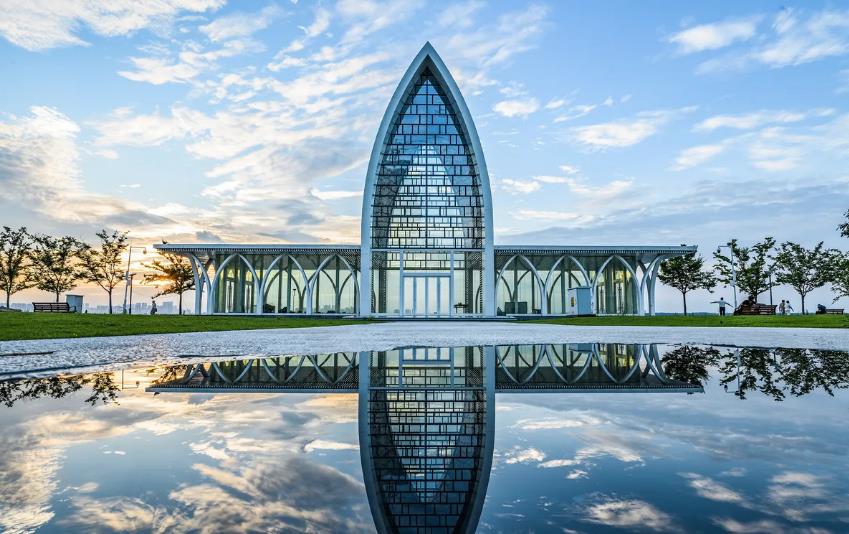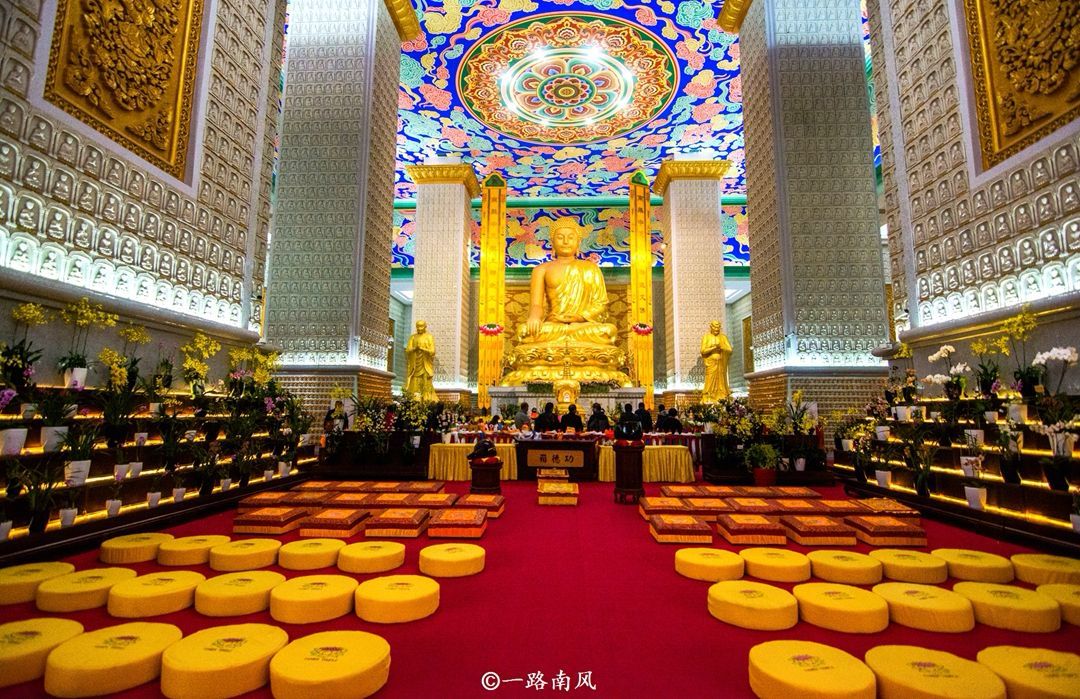https://ae.trip.com/moments/destination-xianyang-632/
2025 Xianyang Travel Guide: Must-see attractions, popular food, hotels, transportation routes (updated in June)
Xianyang (咸阳), once the capital of the Qin empire, China’s first feudal dynasty, is located in the “800-Mile Qinchuan (八百里秦川)” hinterland. Glorious Qin-era architecture can be seen everywhere in Xianyang, which boasts as many as 4951 cultural relics. On Wuling (五陵) Plain are the mausoleums of 28 Hang and Tang dynasty emperors, including Han Gaozu's Changling Mausoleum, Han Jingdi’s Yangling Mausoleum, Han Wudi’s Maoling Mausoleum, Tang Taizong’s Zhaoling Mausoleum, and Tang Gaozong and Wu Zetian’s Qianling Mausoleum. The presence of all these tombs has earned the area the moniker of “the Pyramid Capital of China.”
展示更多
Xianyang今日天氣
Clear 21-34℃

Xianyang的熱門Attraction
Qianling Mausoleum
(24)Shaanxi History Museum
(17)Yuanjia Village
(14)Maoling Museum
(7)Lewa Adventure
(5)Zhao Mausoleum
(3)Han Yangling National Archaeological Site Park
(1)All Moments About Xianyang
It is worthy of being called Xi'an❗️The terminal has a museum, the only one in China
Just finished experiencing Xi'an T5 Terminal, While being so angry that he rolled his eyes, At the same time, I was amazed and screamed. This wave must be talked about! 😣Slot points: 🌀Confusing airport instructions Although there is domestic self-service check-in on the second floor, it is very slow. If you want to choose a safe exit, you have to go to the manual counter on the third floor. 🌀Museum visiting rules Schrödinger The most outrageous thing is the museum on the 4th floor of the terminal! I saw before that you need to make an appointment in advance, but the number of places available each day is limited and it is almost impossible to get one. When I arrived at the museum entrance, I asked the lady if she could let me in to take a look. The lady told me that I could not enter without a reservation (I still had my boarding pass in my hand at the time), so I had to leave in shame. When I returned to the third floor, I overheard a volunteer telling another passenger that "passengers can queue up on-site to visit with their boarding pass on the day," and I was instantly speechless about the staff at the museum entrance. I returned to the museum, registered my boarding pass and was able to enter for the visit. I don’t know why this young lady kept blocking me with my boarding pass. After entering, I found that the exhibition area was indeed not big, but the exhibition layout was indeed exquisite. Xi'an is indeed a city where you can dig up cultural relics with just a shovel! Various jars, ornaments and figurines dug out during the airport construction were directly displayed in the display cabinets. ✨Highlights: Aesthetics of the Tang Dynasty The entire terminal is a collision of modern and classical elements, and the museum's bracket-arched wooden structure brings back memories of the Daming Palace. The "Hundred-Meter Long Scroll" in the departure hall takes the Qinling Mountains as its ancestral vein, showing the magnificence of mountains and rivers and highlighting the historical and cultural heritage of Chang'an. Airport MixC takes off from the spot Although the process tortured me thousands of times, the commercial area is really good! China Resources directly transformed this place into Airport MixC AIRMIXC, and its commercial positioning is close to MixC M1. The future brand business is worth looking forward to! Summary of the guide ✅ Check-in: If you want to save time and check in luggage or need a seat at the emergency exit, go to the third floor → go through security and return to the second floor → the boarding gate is within 8 minutes’ walk ✅ Museum: Travelers do not need to make an appointment, boarding pass = admission ticket! Go directly to the 4th floor to queue up for entry ✅ Photo spots: Imitation Tang Dynasty bracket ceiling + "Hundred-meter Scroll" mural + runway stone floor tiles Finally, I want to say, T5 is like a proud and arrogant Tang-style beauty—she has good looks but a weird temper. It is recommended that you arrive at the airport 2 hours in advance. While complaining, exploring, Maybe you can encounter a cultural relic-level surprise around the corner~ #3月好去地方2025 #西安旅游 #西安好去地方👍 #trip #airport #museum #check-in好去地方Sidney Alva28Xi'an Day Trip: A Must-See Guide to Exploring the Ancient Capital
Hey everyone! Wondering how to spend a day in Xi'an? This guide has you covered! We've got the best attractions, must-try foods, and everything in between. Let's start your Xi'an adventure! -- 🚩Itinerary: Day 1: Zhengguo Canal Tourist Scenic Area -> Yuanjia Village Explore Zhengguo Canal and marvel at the ancient water conservancy project; in the afternoon, head to Yuanjia Village to experience the charm of an ancient village and its rich history and culture. -- Recommended Attractions: 🌟 Yuanjia Village: Stepping into Yuanjia Village is like traveling through time back to the Ming and Qing dynasties in Guanzhong. The folk culture and ancient architectural styles complement each other, immersing you in the river of history. 💧 Zhengguo Canal Tourist Scenic Area: Want to see the ruins of an irrigation project from the Warring States period? Zhengguo Canal is the place to be! It's not only a testament to history but also a natural water conservancy museum, allowing you to appreciate the beauty while admiring the wisdom of the ancient people. -- Things to Pack:🧳 👕 Clothing: March in Xi'an can be chilly, so pack a light down jacket, sweaters, and comfortable sweatpants. 🎒 Essentials: Don't forget your ID card, cash, bank cards, mobile phone, and charger. 💊 First-aid Items: Bring some cold medicine and painkillers, just in case. 🎩 Sun and Rain Protection: Although March in Xi'an is cold, bring a hat, sunglasses, and a small umbrella for both sun and rain protection. -- That's all for your Xi'an trip! We hope this guide is helpful. Have fun and don't forget to like and save this post! 🎉AdventureAcrossBorders4Xianyang! 1 hour drive from Xi'an! A great city with private hot spring courtyards!
We stayed in a courtyard in Xianyang! 🕷️Great location, very close to Huitong Night Market, only one or two stops away! Also very close to Fuyuan Square, very convenient for dining 🍲~ After dinner, you can take a walk along Xianyang Lake to digest, the night view is amazing, and then go back to the hotel for a hot spring bath ♨, it's so comfortable! 🕷️The private hot spring is outdoors, in the courtyard outside the room, and you can fill it twice a day, which is great. Many private hot springs can only be filled once. Afternoon tea 🍰 is also provided, it's very relaxing to enjoy afternoon tea 🍵 while soaking in the hot spring! It's also very photogenic 📷, so relaxing! 🕷️The staff are warm and attentive. Breakfast is delivered to the room in a wooden box, mainly Chinese style, with fruit 🍓 and yogurt, it's more comfortable to have breakfast on the bed while watching TV and enjoying the sun ☀ than having a buffet in the restaurant ✨. 📍Location: Binhe Road, Qindu District, XianyangTranquilityRetreats5The subway goes directly to my favorite ginkgo forest this year.
|A surprising discovery Super niche, no one!! The places I recently visited either didn't have enough leaves on the ground or the leaves on the trees had fallen off. This is the place that made me say "wow." Dense golden leaves Crunchy ground Because I was wandering around, it was almost dark when I arrived. Unfortunately, I didn't capture its beauty. 📍Fengxi Cultural Park 🚇Take the subway to Fengxi Cultural Park Station 🚘There are many parking spaces on the roadside 🏕️Camping is allowed in the parkLiamMaguire8881Qingweilou museum
Location: Qingweilou museum, Xianyang, Shaanxi, China Entrance fee: Free Date: June 14, 2022; March 6 & 28, 2023 Qingweilou is a beautiful museum and art gallery in Xianyang. It’s near Xianyang Lake. The structure is very interesting and stunning. It’s beautiful both daytime and at night. When the lights are turn on it looks really nice. From backside it’s possible to go inside and see the paintings. It’s open from 9am to 5pm, the last entry is 4:30pm. If you’re interested in art, then you can go there and look at the paintings. #xianyang #Qingweilou #temple #museum #artgallery #sunnyday #lights #eveningwalks #niceplace #niceview #attraction #spring #summerhamzyann6Xianyang Lake
Location: Xianyang Lake Scenic Area, Xianyang, Shaanxi, China Entrance fee: Free Date: June 14, 2022 Xianyang Lake looks so nice no matter it’s day or night. People like walking along the lake and looking at the bridge. Sometimes we can see people are flying kites, riding boats, cycling, jogging or just sitting on the benches and chatting. In summer when the weather is very hot, spending time here makes you feel cool and calm. #xianyang #scenicarea #attraction #lake #sunnyday #niceview #summerhamzyann25Xi'an's Neighbour City
Location: Xianyang, Shaanxi province. Getting there: Take a 20 minute taxi from Xi'an airport or simply take the subway from the center of Xi'an...it goes all the way to Xianyang city. The subway stop that links with Xi'an is called Feng He Sen Lin Gong Yuan. Getting off at Feng He Forest Park station, it's a short walk to the center of Xianyang. In xianyang go for walks along Xianyang lake and admire the beauty of the still water. Walk along the mighty bridges and admire the beautiful lights on the road. There are also nice parks nearby with historical statues to learn more about. #xianyang #xian #shaanxiGraeme (高天乐Photographer)16Getting Th
Getting There - easy, 100 didi ride from xian center Attractions - fake looking everything. Hotels - one hotel i didnt visit Food & Restaurants - snack street. didnt try Shopping - tourist trap. It is literally a tourist trap. fake flowers, some statues and lots of tea shops that offer fucha but without the feeling of real tea shop and more like a tourist bleeding center. the museum is worth it if you really are into tea and can understand chinese.Chicken Feet7Han Yang L
Han Yang Ling Everyone heard about terracotta warriors in the mausoleum of Qin Shi Huang Di. Yes, that was pretty impressive. But Xi'an and Xianyang cities have a lot of other tombs with remarkable artifacts. Today I would like to introduce one more emperor tomb - Han Yang Ling located in Xianyang city, which is very close to Xi'an and together they are forming biggest agglomeration in Shaanxi province. The mausoleum has thousands of small figures and sculptures. As in a case of terracotta warriors, all these servants, warriors and animals should accompany their lord in the spirit realm, according to the ancient beliefs. I am very happy I found the time to visit this remarkable place. #culturalattractions#museumquest#historiccultureMaxS5Most Beautiful Sunset in Xian
From winter to spring, you can often see the most beautiful sunsets. This time on the high-speed rail from Yan'an to Xi'an, just in time for the setting sun, the setting sun like a salted egg yolk fell on the vast countryside and the whole process of sunset was appreciated from a different angle on the high-speed rail. If you want to travel to Shaanxi, it is recommended to take the high-speed train from Yan'an to Xi'an, and then from Xianyang International Airport to other cities. #sunset #feb2021 #awesomepicopps-snow28#tripaway
#tripaway it’s my trip from Stockholm Sweden to xi’an China, finally can get back to China even going to stay 14 day in quarantine but it’s fine. wish you all fine trip. #tripawayESMAIL085Xi’An is g
Xi’An is great blend of history and modern city. You’re transcend to China in 618 on one street and back to 2019 just across. What an amazing cultural experience! #merrychristmas #merrychristmasKarebear11This year
This year i have visited China with my beloved girlfriend. It was amazing trip and time in China, exactly at the top of mountain Tai Bai mountains. There are a lot of kind tamples, buildings and people. We have tried chinese food, its was too spicy, but in the end of our journey we are used to eat it, because there were not another choices. Air of that mountain is fresh and clear, easy breathing.E34***3633[Xi'an bes
[Xi'an best fish soup squid hot pot! Soup fresh meat is delicious today, come to the spotted fish hot pot. Located in Zhongmao Square, the Lijiang Longli Group has an elegant decoration style. The squid fish is as thin as a flap, which is translucent and translucent. Because it is cut by live fish, there is a layer of ice on the surface to keep it fresh. Before eating fish, you must first drink their home soup, mellow and nourishing, then eat spotted fish, licking the secret sauce, and bring the tenderness of the fish to the extreme. Of course, you can't afford less hot pot dishes, hand-sliding shrimp, fine beef, etc. It can be regarded as an original, nutritious shop.i_am_SU.4"Where is
"Where is the devil's coming to the world" has recently been particularly hot. In the story, Taiyi was ordered to take Lingzhu to the son of Li Jing's son in Chentangguan. And in Sanyuan, Shaanxi, there is a former residence of Li Jing. The former residence of Li Jing is located in Donglibao, Luqiao Town, 4 km north of Sanyuan County. It was built in the Tang Dynasty and is the former residence of Li Jing in the Tang Dynasty. In mythology, the Tota King of the Four Kings is the prototype used by Li Jing. Li Jing was the Wei Guogong of the Tang Dynasty. He came into the phase and made great contributions to the unification of the Tang Dynasty. He was named Wang Zuozhi by later generations. Tang Suzong also listed Li Jing as one of the top ten famous in history. Cheng Wang Temple. Li Yus father also used Li Jing as a prototype. Todays Li Jings former residence is also rebuilt. There are Tang Dynasty Architecture Reading Hall, Yuchi and Wangyue Building; Song Dynasty Building Hangyun Building and Miaoxiang Pavilion; Qing Dynasty Architecture Wangjiao Building and Wonders Zi Teng holds Yang, meteorites and the epitome of Guanzhong Eight Scenes. The former residence was also the place where Yang Hucheng and Zhou Enlai met during the Xi'an Incident. In the office of Yang Hucheng, there were statues of Zhou and Yang who shared the country's scenes, which truly reproduced the historical scene at that time. The former residence of Jing is very beautiful, and it has attracted many directors to take photos here. For example, "Tang Taizong Li Shimin", "Yan'an", "Defend Yan'an" and so on are all taken here. Most of the buildings in the former residence are buildings in Song and Ming and Qing Dynasties. Tickets cost 20 yuan. There are many tourist attractions in Sanyuan County. If the other ones are finished, it is not bad to turn here.Travel master cao.4Not going
Not going to the beach, it is a hot spring. Maybe this is the correct way to open in winter. "China International Hot Spring Festival" Xianyang Station, explore Haiquanwan. Tips: The resort is a 30-minute drive from downtown Xian and Xian Xianyang International Airport.YO..3As the n
As the name suggests, the Zhou Family Courtyard is the compound of Zhou Jiazhi. The residents of the village are all descendants of the famous Northern philosopher Zhou Dunyi. They live together as a kinship family and have been through 27 generations. Zhou Dunyi takes the lotus self-telling, writes "Ai Lian said", and says "The silt is not dyed, and the sputum is clear and not demon". Since then, "Lotus" has become the spiritual totem of the Zhou clan, and the ubiquitous lotus pattern is precisely the reflection of the famous "Ai Lian". Zhou Dunyi's "Lian" Jie has set a benchmark for people of future generations. At the same time, it is like a spring breeze and moisturizes the Zhou clan. Therefore, after more than 500 years of enduring, and talented people, they wrote "Nine Generations of Three The legend of Jinshi, the story of more than 70 officials at or above the county level in the Qing Dynasty, emerged as such a man. Of course, the beauty of lotus is not only "clean" but also "fragrance". How can I get away with you? Abdominal poetry and gas from China! Su Shi once wrote in "San Yu Tang Ming": "The loyalty of the family is long, the poetry is the longest." A family can live through the big waves of the years, not by chance, but by strict The family style has an inevitable connection. In fact, the descendants of the Zhou family have been observing the ancestral training of "the first class loyalty to the filial son, two things to study and cultivate the fields".樱殇之恋.3China Eastern airlines
It was nice experience with China Eastern Airlines from Qingdao through Xian to Moscow. Beautiful aircraft, nice team, great transfer experience with Xian airport and its lounge. Nice entertainment on the board. I have a chance to see nice modern Chinese cinematography. Great experience. Always try to fly with Skyteam member airlines. China Eastern airlines always make great experiencesWorld traveler ABExplore Xi’an’s Treasures Without Spending a Dime
#freemuseumdays Xi’an, one of China’s most historically rich cities, is home to numerous museums that showcase its ancient heritage. Many of these museums offer free admission on certain days, making them accessible to both locals and tourists. Below is a detailed guide to free entry policies at Xi’an’s major museums in 2025. 1. Xi’an Museum (Xi’an博物院) – Always Free The Xi’an Museum, located near the Small Wild Goose Pagoda (小雁塔), is permanently free to enter, except for special exhibitions. It houses artifacts from Xi’an’s 3,000-year history, including Tang Dynasty relics. Opening Hours: 9:00 AM – 6:00 PM (last entry at 5:00 PM) Closed: Mondays (except national holidays) Reservation Required: Yes (via official WeChat or website) 2. Shaanxi History Museum (陕西历史博物馆) – Free Basic Entry One of China’s top museums, the Shaanxi History Museum, offers free admission to its basic exhibition (pre-booking required). However, special exhibits like the Treasure Hall (¥30) and Tang Dynasty Murals Hall (¥270) require tickets. Opening Hours: 8:30 AM – 6:00 PM (summer), 9:00 AM – 5:30 PM (winter) Closed: Mondays Reservation Difficulty: High (book 3-7 days in advance) 3. Xi’an Beilin Museum (碑林博物馆) – First Wednesday of Each Month The Forest of Stone Steles Museum (Xi’an Beilin Museum) houses ancient Chinese calligraphy and stone carvings. It offers free entry on the first Wednesday of every month (e.g., July 2, August 6, etc.). Normal Ticket Price: ¥65 Opening Hours: 8:00 AM – 6:30 PM (summer), 8:00 AM – 5:45 PM (winter) 4. Terracotta Warriors Museum (兵马俑) – Rare Free Days The Emperor Qinshihuang’s Mausoleum Site Museum (Terracotta Army) rarely has free admission days. However, International Museum Day (May 18) and China’s Cultural Heritage Day (June’s second Saturday) sometimes offer discounts or free entry. Normal Ticket Price: ¥120 (includes Terracotta Pits & Emperor’s Tomb) 5. Other Museums with Free Days Banpo Museum (半坡博物馆): Free on International Museum Day (May 18) Hanyang Ling Museum (汉阳陵): Occasionally free during cultural festivals Tang West Market Museum (大唐西市博物馆): Free basic exhibition Tips for Visiting Free Museums in Xi’an Book Early: Free tickets for Shaanxi History Museum and Xi’an Museum sell out quickly. Bring ID: Free entry often requires a passport or Chinese ID card. Avoid Peak Times: Weekends and holidays are crowded. Check Official Websites: Policies may change; verify before visiting. While Xi’an Museum is always free, others like Shaanxi History Museum and Beilin Museum have specific free days. The Terracotta Warriors rarely offer free entry, so planning ahead is essential. By understanding these policies, travelers can explore Xi’an’s rich history without overspending.MaxSBest place to see terracotta warriors!
#freemuseumdays The Xianyang Museum, located in Xianyang City, Shaanxi Province, is a cultural landmark dedicated to the rich legacy of the Qin and Han dynasties. Housed in a former Confucian Temple built in 1371, the museum was officially established in 1962 and now boasts a collection of over 15,000 artifacts. Among its highlights are approximately 3,000 painted terracotta warriors and horses from the Western Han Dynasty, as well as bronze weapons, jade items, and ancient agricultural tools. The museum is divided into nine exhibition halls, each focusing on different aspects of ancient Chinese life and culture. The Xianyang Museum offers free admission to all visitors and is open from Tuesday to Sunday, 9:00 AM to 5:00 PM, with the last entry at 4:30 PM. Visitors are encouraged to bring valid identification, such as a passport, for entry.Shih Yuin ChewWhere to go for a spring outing? Spend a day "relaxing" at Haiquan Bay
🗺 It feels like ages since I last soaked in a hot spring. Over the weekend, I arranged a getaway with a friend and booked a themed room at Xianyang Haiquan Bay Hot Spring Resort Hotel. The fairytale world theme was absolutely adorable, complete with a little tent ⛺ and full amenities – truly five-star hotel standards! ⛱ Since it's a vacation, we made sure to fully enjoy the hot spring ♨ experience. The facility has three floors: the first floor is the changing area, both first and second floors have soaking pools, while the third floor houses the rest area, cinema, and dining zone. 🏖 The entire place features Japanese-style decor, including the changing area where you can even wear yukata 👘 robes. Xianyang Haiquan Bay Hot Spring World recently launched their cherry blossom 🌸 season, complete with a cherry blossom corridor – perfect for photos when dressed in yukata! ♨ My favorite were the beauty pools – seven in total, each with different scents and benefits: tulip, papaya, lavender, jasmine, aloe, osmanthus, and rose. Soaking in each one was pure bliss. ♨ There are also larger themed pools like Roman, Japanese, Huaqing Pool, Thai, and Dead Sea baths – each offering unique experiences. After soaking, you can enjoy a sauna, apply a face mask, and take a nap – utterly relaxing. 🥢 The third-floor dining area has a Japanese aesthetic with ample seating. Options include Korean kimchi hot pot, mini hot pot buffet, curry rice, sushi, shumai, dumplings, as well as simple spicy rice noodles and minced pork noodles – plenty of variety! Nearby arcade games keep kids entertained while parents dine peacefully. 🛋 Lounge in the birdcage pods, laze in cave sofas, nap in special tents, or watch a movie. After soaking and eating to your heart's content, just "veg out" here – the world feels so wonderful and happiness overwhelming. I remember my last visit to Xianyang Haiquan Bay wasn't this amazing. Now fully upgraded with complete entertainment options, you could easily spend three days here without boredom. For those unsure where to go this spring, bring family or friends 👬 and enjoy a blissfully lazy day here!Trave_sia*Waiting at Xi’an Airport? Visit Their Free Museum!
#airportovernight #xian #airport #museums #thingstodo Tucked inside Xi’an’s new airport (Terminal 5, 4th floor), the Chang’an Everlasting Peace exhibition is a hidden gem where history meets modern travel. Step into a mini-museum showcasing ancient tombs, Tang dynasty relics, and even 2,000-year-old zodiac statues—all unearthed right under the airport! Best part? It’s free for travelers! Snap selfies with artifacts, and peek into Xi’an’s Silk Road glory—all in 30 minutes or less. Don’t miss this bite-sized adventure while waiting for your flight! Ancient vibes + airport convenience = a win for curious travelers!English Guy In Guangzhou2Xi'an airport is an elegant, new airport.
It's not crowded at all. I changed the flight there. The airport offers free accommodations for passengers who are waiting all night for the next flight. I like staying in the airport so I didn't take it. I walked around and took photos. The face recognition board surprised me. I have just walked there it recognized my face and immediately appeared my name and my flight information. #travel #flight #airportRed_bearThe best Yang Rou Pao Mo in XiAn!
Rou Pao Mo is a delicious delicacy in Xi'an to make soup with roasted bread soaked in broth. it has a rich broth made with beef or lamb and big chunks of lamb. served with coriander and scallion and lots of chili oil. the broth is rich but not greasy. the meat is tender and succulent. it is also served with picked garlic that you can crunch your teeth into while you slurp the soup. the bread pieces soaked in broth have the perfect tender consistency!E47***19Must visit Xi'an Silk Road Happy World with your kids during the Dragon Boat Festival!
**Xi'an Silk Road Happy World Travel Guide** Xi'an Silk Road Happy World is a large-scale immersive interactive entertainment park themed around the "Silk Road" culture, blending architecture, culture, technology, and amusement facilities from countries along the Silk Road. It's perfect for families, couples, and friends. Here’s a detailed guide: --- ### **1. Basic Information** - **Address**: Fengxi Cultural Park Station, Metro Line 5, Fengxi New Town, Xixian New District, Xi'an, Shaanxi Province - **Opening Hours**: Weekdays 10:00-18:00; Weekends/Holidays 9:30-20:00 (subject to official website) - **Ticket Prices**: - Adult Ticket: Approximately ¥200-300 (varies by weekday/holiday; discounts available for online purchases) - Child/Student/Senior Ticket: Discounted (valid ID required) - Night Ticket: Available during specific hours (entry after 16:00) at lower prices --- ### **2. Transportation Guide** 1. **Metro**: - Take Xi'an Metro Line 5 to "Fengxi Cultural Park Station" (Exit B1), then walk about 5 minutes. 2. **Driving**: - Navigate to "Silk Road Happy World"; parking available (approx. ¥10/day). 3. **Bus**: - Take Bus 862 or 1067 to "Silk Road Happy World" stop. --- ### **3. Must-Try Attractions & Themed Zones** The park is divided into seven Silk Road-themed zones, each with unique features: 1. **Fantasy Silk Road (China Zone)** - **"Marco Polo Adventure"**: 5D cinema for an immersive Silk Road expedition. - **"Kunlun Mine Coaster"**: Family-friendly roller coaster. 2. **Glory of Rome (Europe Zone)** - **"Odyssey Coaster"**: Northwest China’s longest launched coaster—thrill level ★★★★★. - **Roman Colosseum**: A photogenic spot with grand ancient-style architecture. 3. **Desert Oasis (Middle East Zone)** - **"Golden City Drift"**: Water ride, perfect for summer. - **"Desert Storm"**: 4D cinema simulating Silk Road caravan adventures. 4. **Ganges Elephant Valley (India Zone)** - **"Elephant Valley Mystery"**: Dark ride through a mysterious rainforest. - **Cultural Performances**: Indian dances, magic shows, etc., at scheduled times. --- ### **4. Recommended Itinerary** - **Morning**: Head straight to "Glory of Rome" for thrilling coasters → Watch performances in "Ganges Elephant Valley." - **Noon**: Dine in "Desert Oasis" and try Middle Eastern cuisine. - **Afternoon**: Experience the 5D cinema in "Fantasy Silk Road" → Photo ops in "Sunny Greece" → Cool off with "Golden City Drift." - **Evening**: Catch the parade (around 16:00) → Nighttime light shows (weekends/holidays). --- ### **5. Dining Recommendations** - **Silk Road Food Street**: Local Shaanxi snacks, Turkish kebabs, Indian roti, and more. - **Themed Restaurants**: - "Caesar Restaurant" (Western cuisine) in the Rome Zone - "Silk Road Inn" (Chinese set meals) in the Dunhuang Zone - **Tips**: Bring a water bottle (water dispensers available); snacks allowed in small amounts. --- ### **6. Accommodation Suggestions** - **In-Park**: No hotels on-site, but plenty nearby. - **Recommended Hotels**: - Fengxi New Town Holiday Hotel (mid-to-high-end, 2 km away) - Novotel Xixian (metro-accessible, convenient for travel) - Local B&Bs: Multiple unique options near Fengxi New Town. --- ### **7. Practical Tips** 1. **Download the Official App**: Check real-time wait times, show schedules, and digital maps. 2. **Avoid Crowds**: Weekends/holidays are busier; weekdays recommended. 3. **Attire**: Wear comfortable shoes; sun protection (hats, umbrellas) in summer. 4. **Night Experience**: Light shows and fireworks (on special holidays) are a must-see! 5. **For Families**: Fewer rides for children under 1.2m; plan ahead. --- ### **8. Nearby Attractions** - **Kunming Lake & Qixi Park**: ~8 km away, ideal for evening strolls. - **Book of Songs Town**: Traditional culture and handicrafts (~10 km). - **Fenghe Ecological Scenic Area**: Natural landscapes for cycling or camping. **Wishing you a magical journey at Silk Road Happy World!** 🌍✨DreamyVoyager39Xi'an Inte
Xi'an International Airport_TI***ahThis might be the most tech-savvy spot in Xianyang where you can spend a whole day!!
♛♛→_→ Girls! I discovered an absolutely mind-blowing VR experience in Xianyang—"Chronicles of the Qin Empire"! It instantly transported me back to the Qin Dynasty, and I just had to share! 💥 📍Location: Western AI Innovation Port, Xianyang High-Tech Zone 🌟【6 Must-Try Attractions】🌟 1️⃣ XR World—Choose Between Fantasy or Space Adventures ▪️ Become a wuxia protagonist in seconds! Sword-flying, cloud-riding, or even space exploration! ▪️ 8K ultra-HD real scenes with thousands of fantasy settings to switch, plus a personalized fantasy short film🎥 ▪️ Perfect for photos! Capture every ethereal moment and watch your social media blow up with likes! 2️⃣ AI Robots—Futuristic Tech Show ▪️ Watch robots dance with flawless, synchronized moves—pure sci-fi vibes! 3️⃣ Chronicles of the Qin Empire—Immersive Theater ▪️ A 6-act epic from the "Sand Dune Coup" to "Recreating the First Emperor." Fully immersive, with lifelike recreations of Qin Xianyang City, the Qin Mausoleum, and weapon workshops… Referencing over 20,000 artifacts, it’s like standing in the middle of Qin Dynasty history! 4️⃣ VR Adventure Zone—8 Thrilling Options ▪️ I chose "Dinosaur Adventure🦖" and was instantly transported to the Jurassic era! Dinosaurs up close, mountains and plants so real you could touch them🌿—heart-pounding excitement! 5️⃣ Soaring Over Qin—360° Dome Flight Theater ▪️ Motion seats💺 + giant dome screen = immersive flight over Qin landscapes! ▪️ Experience acceleration, tilting, wind, rain🌧️, and zero-gravity—unbelievably real! ▪️ Fly past the Epang Palace, Qin Great Wall, Zheng Guo Canal… a dreamlike return to Qin’s golden age! 6️⃣ Dome Cinema ▪️ A magical deep-sea journey, as if wrapped in ocean waves. Colorful fish🐠 and jellyfish🪼 dart around—just as you’re lost in the moment, a whale slowly approaches, flips its massive body, and disappears into the deep blue with a silent vortex. The visuals were so lifelike I couldn’t resist reaching out to touch them. ✨This place is the perfect fusion of tech + history! 100x more fun than traditional theme parks—I could stay all day and never get bored~Lily~CookThere is a very beautiful Xi'an!
Xi'an is so beautiful and poetic, will come back._TI***ao

Popular Xianyang Topics

Guides
162 posts

Attractions
128 posts

Hotels
48 posts

Destinations related to Xianyang

Xi'an
5303 posts

Baoji
148 posts

Mount Hua
28 posts
- 1
- 2
- 3
- 4
- 9
Post
更多推薦
Popular Trip Moments
Explore Xi’an’s Treasures Without Spending a Dime | Best place to see terracotta warriors! | Where to go for a spring outing? Spend a day "relaxing" at Haiquan Bay | Waiting at Xi’an Airport? Visit Their Free Museum! | Xi'an Lehua City Amusement Park|Instantly Transport to Thailand! | Xi'an airport is an elegant, new airport. | Ultimate Guide to Xi'an Must-Visit Lehua City Happy World | Huimin Street: A Culinary and Cultural Gem in Xi’an | Must visit Xi'an Silk Road Happy World with your kids during the Dragon Boat Festival! | Lehua City 88℃ Hot Spring Water Park Travel Guide | This might be the most tech-savvy spot in Xianyang where you can spend a whole day!! | A Tranquil Moment Under a Millennium of Buddha's Light | Personal experience of Xianyang Baode Haiyu Hotel: good experience of the new hotel | Stay at Nanshan Hotel in Panzhihua | Treasure Hotel on the shores of Xianyang Lake | I've been to Lehuo Hengye Happy World 5 times and finally figured out how to enjoy it properly. | Zhengguo Canal: A Symphony of Ancient Relics and Natural Beauty | Xi'an 4-Day, 3-Night In-Depth Tour! A Tang Dynasty Girl's Grand Adventure~ | **Transit benefits during the May Day holiday! Ibis Styles Hotel next to Xi'an T5 Terminal, you can have fun while waiting for the flight✈️🌸** | Niche but Wonderful Xi'an Travel: Recommended Qin and Han Dynasty Themed Museums | Xi'an|Shaanxi History Museum-Qin and Han Dynasty Museum | [Xi'an Xianyang International Airport T3] China Southern Airlines Business Class Lounge Experience ✈️✨ | เมืองโบราณซิงผิง (Xingping Ancient Town) 🇨🇳 | A must drink at Xi'an Airport! Old Lanzhou Yogurt All Flavors Unboxing Recommendations | Zhengguo Canal: Must-Know Tips | It is worthy of being called Xi'an❗️The terminal has a museum, the only one in China | Qianling Mausoleum - Yongtai Princess Tomb
| Misty Rain in Jiangnan - Spring at West Lake | Sanyuan Chenghuang Temple: A Hidden Gem Awaits | Journey Through Time: Discover the Scenic Beauty of Zhengguo Canal
Recommended Attractions at Popular Destinations
Bangkok attraction near me | Manila attraction near me | Tokyo attraction near me | Taipei attraction near me | Hong Kong attraction near me | Seoul attraction near me | Kuala Lumpur attraction near me | Los Angeles attraction near me | Shanghai attraction near me | New York attraction near me | Shenzhen attraction near me | Osaka attraction near me | Singapore attraction near me | London attraction near me | Guangzhou attraction near me | San Francisco attraction near me | Beijing attraction near me | Macau attraction near me | Bali attraction near me | Jakarta attraction near me | Paris attraction near me | Ho Chi Minh City attraction near me | Istanbul attraction near me | Phuket attraction near me | Chicago attraction near me | Seattle attraction near me | Toronto attraction near me | Orlando attraction near me | Cebu attraction near me | Chiang Mai attraction near me
Popular Restaurants in Xianyang
Haidilao Hot Pot (Datang Shop) | 星河湾酒店·真粤中餐厅 | Hongluo Harbor Holiday Hotel·Restaurant | 海底捞火锅(咸阳丽彩万达店) | DQ | Fuyuan Alley | 奥赛奥自助烤肉(财富中心店) | 南城小馆·酸菜铜锅涮肉馆(渭城总店) | 老爸的咖啡馆(中山街店) | Xiaoliutangbao (zhengxingguangchang) | 陕拾叁(袁家村店) | Malakongjian (tuanjieluzong) | Near No.301 Provincial Road | 正宗八亩沟妙轩擀面皮 | 星巴克(咸阳市袁家村店) | BI SHENG KE SHI JI DIAN | Xiaoliutangbao (shijidadao) | 京小涮涮羊肉(大沃城店) | 光阴和故事 | GOU BA DOU FU NAO | CoCo都可(咸阳万达店) | 九门巷子里韩式烤肉(兴平店) | 宁夏同心小杨新开饭店(壳牌加油站店) | 盛唐府乾州酸汤面 | Qianjiaculiangwang (zhengxingguangchang) | 兄弟铁锅炖(秦都店) | Flower Time Cake | You'ercaihong Cake (yongsuijie) | 一只酸奶牛(万达店) | 雪美蛋糕(荣成西苑店)
Popular Ranked Lists
Popular Must-Visit Restaurants in Bangkok | Popular Best Things to Do in Qianwei County | Popular Best Things to Do in Wuzhishan | Popular Best Things to Do in Ziyuan | Popular Best Things to Do in Jiange | Top 10 Local Restaurants in Malay | Popular Luxury Hotels Near Mount Sanqing | Popular Premium Hotels Near Hunan | Popular Best Things to Do in Loudi | Popular Must-Visit Restaurants in Santorini | Top 9 Local Restaurants in Lushan Global Geopark | Popular Premium Hotels Near Jiangxi | Popular Must-Visit Restaurants in Barcelona | Popular Luxury Hotels Near Zhejiang | Popular Must-Visit Restaurants in Florence | Popular Must-Visit Restaurants in Madrid | Top 4 Best Things to Do in Sanjiang | Top 4 Best Things to Do in Jingxi | Popular Luxury Hotels Near Yantai Changdao Island | Popular Luxury Hotels Near Yongde | Popular Must-Visit Restaurants in Osaka | Top 15 Local Restaurants in Tai'an | Popular Must-Visit Restaurants in Kuala Lumpur | Top 4 Best Things to Do in Changji Prefecture | Top 18 Local Restaurants in Dunhuang | Top 10 Local Restaurants in Sao Paulo | Popular Best Things to Do in Leye | Popular Best Things to Do in Wuzhong | Top 5 Best Things to Do in Tonghua | Popular Must-Visit Restaurants in Fukuoka
Payment Methods
Our Partners
Copyright © 2025 Trip.com Travel Singapore Pte. Ltd. All rights reserved
Site Operator: Trip.com Travel Singapore Pte. Ltd.
Site Operator: Trip.com Travel Singapore Pte. Ltd.